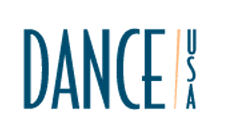
Jul 26, 2021 | By Lauren Warnecke
Margi Cole has moved to Alabama after 26 years at the Dance Center of Columbia College Chicago. Cole hails from Springfield but spent most of her career thus far in Chicago. She’s a 1990 graduate of the Dance Center and earned her MFA at the University of Illinois – Urbana-Champaign before settling in Chicago. Cole joined the Dance Center faculty in 1995, starting her company, The Dance COLEctive, a year later.
This fall, Cole will start a full-time position in Birmingham, Alabama as one of four dance faculty members teaching approximately 50 students at the Alabama School of Fine Arts. It is familiar territory; Cole met Wes Chapman, ASFA’s dance chair, when she was 15 years old and a student at the school. She has strong ties to arts organizations across the state, including Alabama Ballet.
Known for her quirky style and steadfast consistency, Cole is a mainstay at the Dance Center. But her classes have rarely, if ever, been guaranteed. “For the past 30 years I’ve always had at least three part-time jobs,” Cole said. Over the years, she took on additional responsibilities at the Dance Center, including a stretch as associate chair and a role supporting the Dance Presenting Series. She’s served on boards (including that of See Chicago Dance) and countless committees.
With fluctuations in enrollment and curriculum changes at the Dance Center (plus a global pandemic thrown into the mix), Cole was attracted to the stability of a full-time job and will be teaching modern dance for students in grades 7-12. “Teaching is my passion and all of these other things have helped keep my life glued together,” she said.
During the pandemic, Cole focused much of her energy on sifting through the Dance COLEctive archives, culminating in a series of virtual watch parties and a social media campaign commemorating the company’s silver anniversary. “It has been pretty cathartic,” Cole said, to work through decades of costumes, photographs, programs, videos and press clippings. “I’m not done with it,” she said. “I have a pile of stuff that will probably have to be put in a box. But I whittled everything down to a folder for each year. It’s a librarian’s dream.”
The pandemic also tested Cole as a teacher. “I can’t even begin to tell you what I learned and how much compassion I have for the young people who had the wherewithal to show up,” she said. “Twenty-five years of teaching couldn’t prepare you for a year and a half of teaching on Zoom.”
Run out of a rinky-dink space near the corner of Lawrence Ave. and Sheridan Rd. (luxurious for its time), Columbia College’s dance department was quite clearly an extension of its founder, Shirley Mordine, when Cole arrived there as an undergrad in the late 1980s. Generations of dancers, taught from the Dance Center’s present home in the South Loop by Cole and her contemporaries—including several faculty who were influenced by Mordine’s iconoclastic teaching methods and modern dance aesthetic as members of her professional company—tie the Dance Center indelibly to its matriarch. After Mordine stepped down in 1999, subsequent chairs (Bonnie Brooks, Onye Ozuzu, Peter Carpenter and Lisa Gonzales) have wrestled with the complicated task of preserving the Dance Center’s legacy while moving toward necessary change. It’s resulted in a muddled identity despite positive outcomes.
“The Dance Center is trying to respond to the field of dance at large by not privileging particular forms, opening the door for other forms to be elevated,” Cole said. “In the beginning, I was resistant to it. The artform that was the central focus was not central anymore, which made me less relevant. But I think it’s all necessary and, in hindsight, I can see how it has a really positive impact on the students.”
The Dance Center’s concerted efforts surrounding diversity, equity and inclusion began approximately 10 years ago, well before many of their institutional peers. “Lots of people have had a light shined on them around this work,” Cole said. “Our department has been doing it and it hasn’t been elevated as an example in a public forum.”
Cole purports that the Dance Center’s approach has always been inclusive. Columbia College’s open enrollment policy makes it possible for almost anyone to pursue dance training who wants it. The Dance Presenting Series is another example. “If you look back at the 47 years of presentations and look at the rosters, Shirley was forward-thinking,” Cole said. In essence, loosening the grip on Mordine’s aesthetic is aligned with her vision from the get-go.
True to form, Cole’s decision to leave is not purely about her, though she’s excited about the stability it will afford her. “I feel like the field needs to change—I need to change,” she said. “What better place to have an impact then to start sooner in a young artist’s trajectory? If a young dancer can be thinking about doing ballet and modern and yoga, but also be thinking about decolonizing dance—maybe it could impact the field faster.”
In addition to teaching at ASFA, Cole plans to continue The Dance COLEctive in Birmingham. In 2016, she disbanded the ensemble, opting to focus on solo works. In large part, it was a pragmatic decision that allowed her organization to be flexible enough to accommodate a move. Though that move has finally come to pass, Cole hopes to remain connected to Chicago. But with an equal mix of excitement and fear, she feels fortunate for the fresh start.
“How lucky am I to be in the middle of my life and get start over?”

And then there’s Margi Cole, whose company, The Dance Colective, appeared in HCCDF on a few other occasions. Cole folded her ensemble in 2016 as a response to the increasing unsustainability of running a dance company, and has since focused almost entirely on producing solo works. Honestly, it’s a blessing. Cole, as a performer, is ineffable, blending a specific brand of humor and wit cultivated over her 25 years of teaching and making dances. Those little “Margi-isms” are crystal clear in “My Sufi Tale,” a solo Cole made in 2012 as part of the Chicago Moving Company’s Cover Band project. “My Sufi Tale” is a remix of a work by CMC’s late founder, Nana Shineflug.
Cole sits on a forest green milk crate, reads from a book on the chakras, and proceeds to build a silly dance in pursuit of freeing a blocked heart center. In the process, she dons iridescent green pants and green sweatbands, talking us through her self-guided journey toward healing. “This is a story about survival, and each of us does it in our own way,” she says twice in the short, but poignant solo.
Continue reading here

In 2016, veteran choreographer, dancer and educator Margi Cole announced she was folding her Dance COLEctive ensemble after 20 years of operation. Rather than continuing as a conventional dance company, Cole opted to shift her focus toward solo works and a project-based model. The goal? Sustainability, particularly in a Chicago arts landscape that increasingly favors independent artists and longer, deeper creative processes.
After a year and a half of incubation, The Dance COLEctive re-emerges this weekend with “REboot,” a quick hour of dances by Cole, Peter Carpenter and Colleen Halloran. Considered together, these three have built the choreographic foundation for generations of dancemakers (this writer among them) through their roles as long-time faculty members at the Dance Center of Columbia College. Completing the circle, the evening is produced by Third Way Projects, a platform created by the former chair and Dance Center presenting series director Bonnie Brooks, who retired from Columbia in 2017.
It’s not lost on me how vulnerable it must feel to continue to present work, and to push oneself to evolve and adapt, when there’s really no pressure to do so. And it occurs to me that these stalwarts of Chicago’s contemporary dance scene now make and produce dances because they want to, not because they have to, and maybe that’s why “REboot” doesn’t feel like “just another dance show.”
Continue Reading HERE
2018
Site-specific work: Leave no stone unturned
Have you ever suddenly noticed an area which you walk past every day – really seeing it for all its nooks and crannies, colors and shadows? Or gone to a place for the first time and felt its power? Has this inspired you creatively – to dance and choreograph, to improvise and collaborate? You’ve tapped into the unique magic of site work. Yet the challenges that can evolve on the way to getting there – weather-related, legal, technical and more – can certainly be less magical.
To get a better idea of what these processes can be like, as well as how to ensure that they run as smoothly as possible (as much as we artists can control that), Dance Informa talked with three choreographers experienced with site-specific work: Heather Bryce (Bryce Dance Company, NYC), Margi Cole (The Dance COLEctive, Chicago, IL), and Callie Chapman (Zoe Dance, Boston, MA). They also all shared something about how and why site work can be so very well worth the hassles of handling these challenges. Let’s jump in!
Margi Cole
“There are two main ways, that I’m aware of, to make site work – to adapt a pre-existing piece to fit a space, or to make a work around a space. I tend to make a work around a space; I’ve found that it comes together better and honors the space. I think of the space as a container for the work, as well as often an inspiration for it.
I love how site work allows audience members to leave when they want, engage with it how they want. It allows them to have ownership over the work, and to see things through a different lens. It can be in a space where only five people can experience the work, or where hundreds can, such as a state fair. It opens up more possibilities.
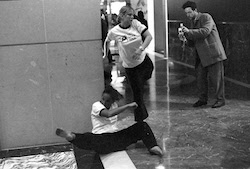
The Dance COLEctive. Photo by Jason Salerno.
In one site work, Gorham’s Bluff, we performed on southern porches. They’re important in the south, a social location. This social custom was the catalyst for the work; we wanted to highlight more than just the physical space but also what happens there. We went porch to porch, dancing and incorporating community members.
In Plain Site was another site work at the Illinois State Fair. We purposefully performed everywhere that was not a stage, to bring attention to spaces not otherwise seen. We danced for three days on the fairgrounds, six to eight performances each day, with eight dancers.
Half of the performances were publicized, and half were not. When audiences didn’t know it would happen, they would break the fourth wall. This built a more mutual feeling between audience and performer. It brought into question social airs, how we interact with one another.”
Article continued here.
Dance COLEctive Profile- Meet Margi Cole
The world of dance is a beautiful, fast-paced, exciting, competitive, and ultimately very difficult place in which to live. Becoming successful as a dancer requires an intense amount of dedication and love for the art- and it doesn’t hurt to have a little help. For countless dancers inside and outside Chicago, Margi Cole is that help. She is the guide, the teacher, and most of all, the mentor to all kinds of dancers trying to find success in the field that they love.
From childhood Margi Cole knew that she was meant to perform. “At a very young age,” she tells us, “I would create and perform my own dances in my garage at home, entertaining my family with my love of the art.”
As Margi grew up her creativity and talent flourished, taking her to Columbia College in Chicago and gaining her a new mentor- Laura Dean. From that moment on Chicago was Margi’s home, a place in which she would flourish as a dancer, choreographer, entrepreneur, teacher, and mentor.
To read the full article, click here.

Photo by Lisa DeShantz-Cook
Chicago’s The Dance COLEctive shifts structure
June 2017
People, being people and thus seeking the greatest gains, have always tried to find and stick with the most effective ways of work. This is common across sectors and disciplines, in for- and not-for-profit ventures, including those in dance. Every so often, however, an entity changes course from the prevailing model.
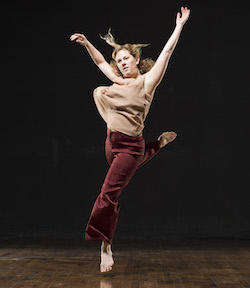
Margi Cole. Photo by William Frederking II.
Those at the head make decisions to do so sometimes out of necessity, sometimes out of choice and sometimes because of a mixture of both. Margi Cole’s The Dance COLEctive (TDC) is such an entity that has stepped outside traditional structures and norms. Dance Informa recently spoke with Cole about the company’s recent shift. The Chicago-based company has been a contemporary ensemble for 21 years.
Cole fondly describes how many company dancers had danced for her for many years, staying with her in the sometimes difficult creative process. From that, they built meaningful working relationships. They came to learn how to work together, as artists and as individuals, in deep and cohesive ways. On the other hand, “it got harder and harder to present dance in proscenium spaces, uphold the expectations of a ‘company’ model, and to be accountable to those in the room who are working for you,” as well as to funders and board members, Cole explains.
At the same time, she was yearning to more deeply explore her artistry as a performer and as a collaborator. It got harder and harder to reconcile with those urges and still keep that accountability, she says. After much soul-searching and feedback from trusted others, she decided to shift course. A press release from the company states, “TDC, as it reaches its 21st birthday (March 8, 2017), announces a fundamental shift in its mission, organizational structure and artistic focus.”
This shift includes a “move from maintaining an ongoing ensemble of dancers to a project-based structure, hiring dancers as projects dictate, whether they are created and performed under the TDC banner, with other companies or in collaboration with other artists,” according to the press release. Cole herself will “engage in a solo-focused initiative during the next 18 to 24 months,” in which she will “dance and create/commission solos she intends for performance in a variety of traditional and site-specific settings.”
To read the full article, click here.
By Kathryn Boland of Dance Informa.
The Dance COLEctive Switches Gears 
Finding just the right model for a dance company is important, and there is no one-size-fits-all solution for every company out there. Margi Cole has been at the helm of The Dance COLEctive, a Chicago-based dance company, for two decades–and recently decided to change the model she had been using to something that will allow her to expand her work, while shifting the format around a bit.
We sent Margi some questions about this change so readers can take a look at what she’s doing, and why. She has some interesting thoughts to share…
Would you summarize the recent announcement about your company, The Dance COLEctive for our readers?
Basically, The Dance COLEctive (TDC) is transitioning to a new model. After 20 years, we will no longer maintain and work with a company of dancers on a continuous basis but will “pick up” dancers as needed for specific projects. While this is not a new idea, it is a new way to work for me and for TDC.
To be clear, the organization is not folding and I am not quitting. TDC’s new model will enable me to expand my work in several different ways:
- Developing a solo-focused initiative: creating, commissioning and highlighting solo work
- Creating new works to perform under the TDC banner, with other companies or in collaboration with other artists
- Increasing national and international teaching and creative residencies
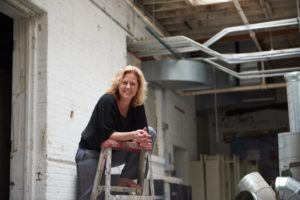
I guess the biggest question that comes to mind is, why is the shift happening now? After all this time, all these years, what was it that was going on under the surface that moved you in this direction at this particular time?
I am responding to changes in the field, the shifting economic and political climate and my own interests and needs as a mid-career artist and adapting to create sustainability for my organization. I want to shift my accountability from that of an organizational structure to the creative process, which was my basis for starting the company. Without an ongoing group of dancers, I’ll more time and space to be more fluid with the projects I am working toward completing.
Is this a “fluid” shift in focus? Meaning, will you decide as you go along how much time and focus each area will receive? Or do you have an idea of how you might like to structure your efforts moving forward?
My new focus means that I am looking in places for opportunities and resources. Right now, I am working toward immersing myself in the creative process, so I’m focusing my efforts on researching funding and residency opportunities and strategizing artistic collaborations and projects. My primary focus at the moment is the Solo Swap Project, which will provide me with more flexibility if something comes up and allow me more time for research and development.
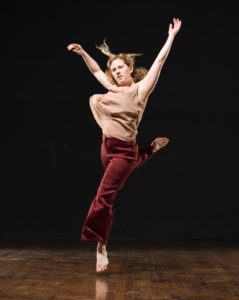
You have always valued mentoring. How do you see your role as a mentor evolving in this new format?
Yes, mentorship has turned into a central focus for me, and it continues to be important and valuable to my plans. First, I have formalized something that I have always done: How to make it work or at least give it a try. I have always talked with people informally about the field and sometimes offered advice, feedback and resources. Not only does formalizing these conversations add value to what I am doing, it is generating revenue for TDC. I also discovered that I need administrative support. I have engaged a former company member to help me with some tasks as a way for me to provide guidance through arts administration. I am seeking opportunities to mentor choreographers in the studio. Thodos Dance Chicago invited me back to participate as a mentor in its New Dances Project as a resource giving feedback during their rehearsal process. I expect that opportunities will continue to present themselves and evolve. Mentorship remains a key element of the organization and a core value for me as an artist.
Can you talk a bit about the idea behind the Solo Swap Project, and how that idea came to pass?
I have always been committed to my solo work. It has been a way for me to put my money where my mouth is in terms of my expectations of others and my own work as a director. I want to continue this work and make it more of a central focus. The Solo Swap provides a framework for collaborative development and aims to develop scaleable work while expanding, exploring and deepening the participants’ work as artists. In short, this idea embodies all the elements that seem practical in our shifting economic climate and gives the participants the opportunity to customize work while simultaneously challenging themselves. As it turns out, this will enable me to do all of the things I am interested in: be collaborative, portable, mobile, a dancer and a choreographer.
For you personally, what do you see as your biggest hope moving forward in this new format, and in these new endeavors?
To find a renewed sense of creativity and spirit, to work toward creating a more sustainable business model, to be a role model in terms of change and to support my ongoing curiosity about the field of dance inside and outside of the studio. I hope this will enable me to teach more, perform more, make more dances and be a more viable contributing artist to my own community and beyond.




